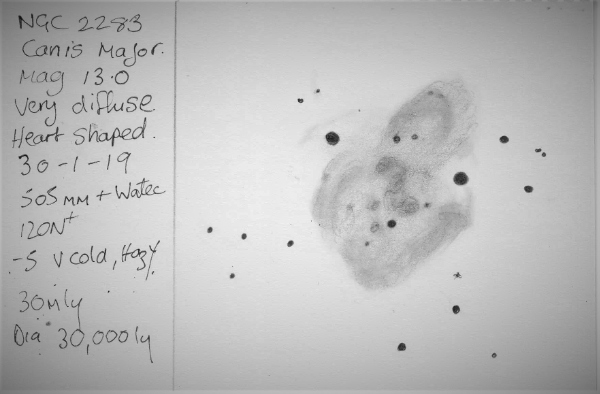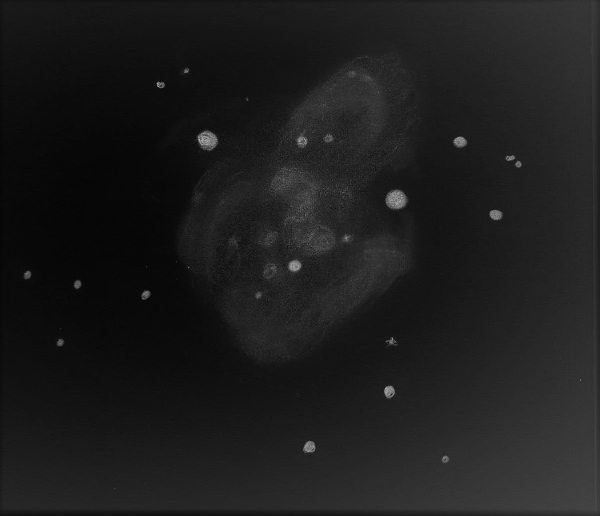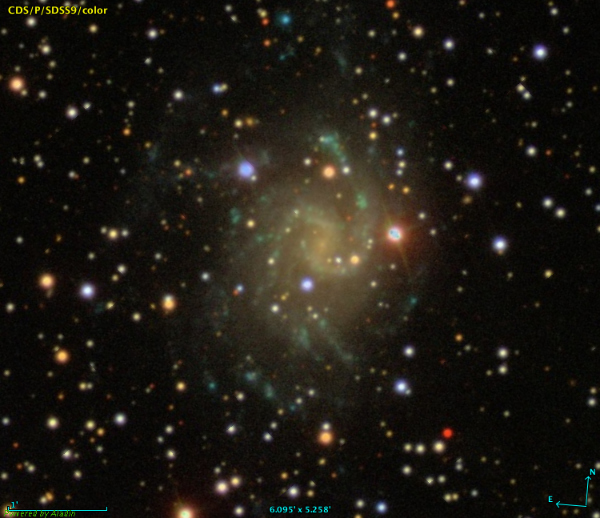These are our observations in Canis Major
-
Observational Sketches
Dale Holt recently sent me a large selection of sketches, for which I have to thank him. I've taken the liberty of selecting a few that I find interesting because of the process they show.
NGC 2283 in Canis Major
The first is Dale's pencil sketch of this galaxy showing his annotations. He's back to using his 505mm Newtonian with an analogue Watec 120N+ camera.

An EAA pencil sketch of NGC 2283 by Dale Holt from his Chippingdale observatory in Hertfordshire. Next Dale's reversed the first sketch to provide a light on dark sketch that can help detail pop out. It's perhaps a better representation of what you see in an eyepiece of a really large scope with nice skies.
However Dale's using Electronic Assistance (EA) here to view on a monitor under (as he mentions in his notes) hazy British skies. I expect that's what he's going to talk about at our Annual Meeting in Cambridge this summer when he "goes deep on the cheap".

Here Dale's reversed the first sketch to provide a light on dark view of NGC 2283 I couldn't resist comparing that view to the Sloan Digital Sky Survey (SDSS). I think that Dale's capturing a fair amount of the detail in the image below, especially around the bar. The Digitised Sky Survey (DSS) isn't as detailed as Dale's view.

The Sloan Digital Sky Survey (SDSS) view of NGC 2283. NGC 2683 in Lynx
The final sketch I'd like to present represents a change in drawing technique. Dale says that he found this galaxy
stunning
and decided to usepastels on black paper as opposed to my usual graphite on white
. It has a much softer feel than the pencil sketches.
An EAA sketch using pastels on black paper of NGC 2683 by Dale Holt from his Chippingdale observatory in Hertfordshire. James Whinfrey - (4 March 2019).
-
Observing at Teggs Nose with Binoculars
I was lucky enough to see a clear sky during Friday evening. After the rain had cleared off. The skies were clear although. There was a lot of moisture around. This moisture eventually froze out. Leaving a sharp hoar frost at dawn.
Tegg's Nose country park was my destination. I travelled up there from my home in Macclesfield. Although this site is not far from the centre of the town. The skies can be quite dark. Normally we can see magnitude 4.6 stars, and on those rare occasions, magnitude 5.
The Moon was visible during the early evening. But she wasn't a problem. It was a thin crescent hanging majestically in the western sky.
I was with members from my local astronomical society's observing group. And we had a good time.
I was up there to take pictures of Orion and the famous nebulae. But I also wanted to use my 20 x 70 observation binoculars.
M42 was a magnificent sight through my tripod mounted binoculars. I counted all four stars of the trapezium, and I was able see Sigma Orionis and see the companion stars.
Lepus the Hare was very clear last night. The Alpha and Beta stars were crystal clear. I thought I might see M79. But I failed. I will try again on the next clear, Moonless night we have.
Messier 41 was very clear, together with Sirius.
NGC 2237, the open cluster at the centre of the Rosette nebula. Was another easy target. And comet Catalina was a large fuzzy blob just North of Alkaid.
M42 and the nebula NGC 1973-75-77 are shown in this picture. I used a Canon 1000D with a 200mm Pentacon telephoto lens. This was attached to my Skywatcher Star Adventurer.

Paul Brierley - (16 January 2016).